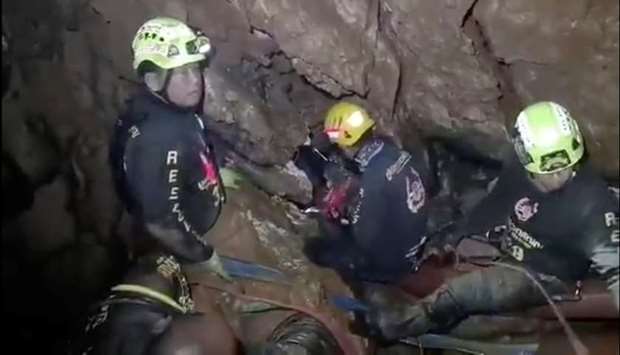Thirteen fully staffed medical teams stand ready round the clock outside a cave in Thailand -- each with its own helicopter and ambulance -- one for each of 12 boys and their coach trapped inside as a daring rescue gathers pace.
With oxygen levels dropping and rainstorms forecast, time is running out on a plan to teach the boys - some as young as 11 and not strong swimmers - to make a dive through narrow, waterlogged passageways that would challenge experienced cavers.
Medical staff involved in the mission told Reuters their first assessments will focus on the boy's breathing, signs of hypothermia and an airborne lung infection known as 'cave disease' which is caused by bat and bird droppings and can be fatal if it is untreated and spreads to other parts of the body.
Authorities have not ruled out laying an oxygen line and leaving the boys inside for months until monsoon rains clear if their efforts over the next few days fail.
"We have set up 13 teams for each of the children," said Major General Pramote Imwattana of the Army Medical Department in charge of the medical operation at the Tham Luang cave complex near Thailand's northern border with Myanmar.
Each boy will have a devoted medical unit consisting of at least one doctor, two nurses, a paramedic and an ambulance, one medic told Reuters, on condition of anonymity because she wasn't allowed to speak to media.
After the initial assessment, the group will be driven by ambulances to makeshift helipads and airlifted to the Chang Rai hospital some 70km away, Pramote said.
"It takes 10 minutes to get from our field medical tent to the helipad and about 15 minute in the air to the hospital."
Preparing
Medics have been conducting regular drills at the camp, ferrying would-be patients in stretchers hundreds of metres through thick mud from the cave's entrance to the road where the ambulances -- assembled from across the country -- wait.
Videos of the boys after their discovery on Monday showed them looking frail, thin and exhausted. But they appear to have remained in good spirits, and the head of the rescue mission, Narongsak Osottanakorn said Saturday that the boys' health was the "best yet" as were the conditions to spring them to safety.
Heartfelt letters delivered by divers from the boys to their family waiting outside the cave on Saturday spoke of them feeling healthy and strong and wanting to go home.
Getting to the muddy bank where the boys sought refuge takes a nearly 11-hour round trip through 4 km of winding submerged pathways and fast-flowing freezing water.
The death of a former Thai Navy seal who fell unconscious during a dive in the cave on Friday, underscores the challenge that awaits the boys.
"Hypothermia is the scariest condition. The body temperature drops as the water is very cold," said the medic, adding that a whole section of the hospital had been set aside for the boy's treatment.
"But what we're most concerned with is infections. There are all kinds of diseases in the cave, from bats, from dirty water. Everything in there is very dirty."
She said histoplasmosis, also known as "cave disease" was one concern as was leptospirosis, an infection caused by bacteria which can lead to severe bleeding from the lungs or even meningitis.
When Chilean miners were rescued after more than two months trapped underground in 2010, some were suffering from pneumonia, lung conditions from inhaling dust and dental and eye problems.
Aside from the physical illness, there is also the psychological strain of living in the dark hundreds of metres underground. Insomnia, depression and post-traumatic stress will all have to be monitored in the weeks after.



